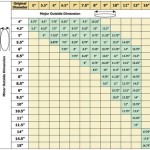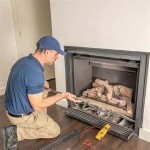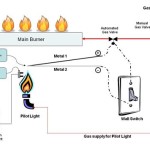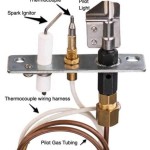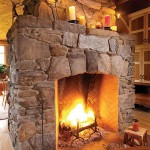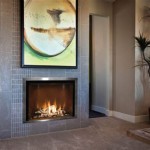Fireplace Surround Ideas With Tile: Elevating Your Hearth Design
The fireplace, traditionally the heart of the home, offers a focal point for gathering and relaxation. The surround, the decorative facing around the firebox, is a crucial element in defining its aesthetic appeal. Tile provides a versatile and durable material choice for fireplace surrounds, offering a wide array of design possibilities to complement any interior style. This article explores various fireplace surround ideas using tile, highlighting different tile types, patterns, and design considerations.
Tile Material Options for Fireplace Surrounds
Selecting the appropriate tile material is paramount, considering both aesthetics and functionality. Different tile materials offer varying levels of heat resistance, durability, and visual impact. The choice depends on the desired style, budget, and the fireplace's heat output.
Ceramic Tile: Ceramic tile is a popular and affordable option. It is relatively easy to install and maintain, and comes in a vast selection of colors, sizes, and patterns. Ceramic tile is generally suitable for fireplaces with lower heat output, as it may be more prone to cracking under extreme temperatures. Glazed ceramic tiles offer a protective layer, making them resistant to stains and moisture. The availability of different textures and finishes allows for diverse design implementations, from smooth, contemporary surfaces to rustic, textured looks. It’s also relatively easy to cut and shape for intricate designs.
Porcelain Tile: Porcelain tile is a denser and more durable option than ceramic. Its lower water absorption rate makes it more resistant to cracking and staining, making it suitable for fireplaces with higher heat output. Porcelain tile is available in a wide range of styles, including those that mimic natural stone, wood, or concrete. This versatility allows for achieving a specific aesthetic without the maintenance concerns associated with these natural materials. The manufacturing process enables the creation of complex patterns and textures on porcelain tiles, expanding the design possibilities for fireplace surrounds.
Natural Stone Tile: Natural stone tile, such as marble, granite, slate, and travertine, offers a luxurious and timeless appeal. Each stone tile possesses unique veining and color variations, creating a distinctive and elegant look. Natural stone is highly durable and heat-resistant, but some types may require sealing to protect against staining and moisture. Marble, with its classic veining, lends itself to formal and sophisticated designs. Granite, known for its strength and durability, is suitable for high-traffic areas. Slate offers a more rustic and textured appearance, while travertine provides a warm and earthy feel. The installation of natural stone tile often requires specialized skills due to the varying thicknesses and weights of the tiles.
Glass Tile: Glass tile offers a sleek and modern aesthetic. It is available in a variety of colors, shapes, and finishes, allowing for creative and eye-catching designs. Glass tile is non-porous and easy to clean, making it a low-maintenance option. However, it may be more susceptible to scratches than other tile materials. Metallic-infused glass tiles can create a shimmering effect, adding a touch of glamour to the fireplace surround. The reflective properties of glass tile can also help to brighten the surrounding space. Installation typically requires specialized adhesives and techniques to ensure proper adhesion and prevent moisture penetration.
Metal Tile: Metal tile, such as stainless steel, copper, or bronze, provides a contemporary and industrial look. It is highly durable and heat-resistant, making it suitable for modern fireplace designs. Metal tile can be used as an accent or to cover the entire surround, creating a bold statement. The metallic sheen can add a touch of luxury and sophistication to the fireplace area. Care should be taken to select metal tiles that are specifically designed for fireplace surrounds, as some types may be prone to discoloration or tarnishing under high heat.
Design Styles and Tile Patterns
The tile pattern and design style should harmonize with the overall aesthetic of the room. Different tile patterns can create distinct visual effects, ranging from classic and traditional to modern and contemporary. Careful consideration should be given to the size, shape, and color of the tiles to achieve the desired look.
Traditional Design: Traditional designs often incorporate classic tile patterns such as subway tile, herringbone, or basketweave. Neutral colors like white, cream, and beige are commonly used to create a timeless and elegant look. Natural stone tiles, such as marble or travertine, are also frequently used in traditional fireplace surrounds. Details like decorative moldings and corbels can further enhance the traditional aesthetic, creating a sense of formality and sophistication. The grout lines are often kept narrow to create a seamless and refined appearance.
Modern Design: Modern designs often feature clean lines, geometric shapes, and minimalist details. Large-format tiles in neutral colors like gray, black, or white are commonly used. Linear patterns, such as stacked or horizontal layouts, emphasize the sleek and contemporary aesthetic. Glass tile or metal tile can also be incorporated to add a touch of visual interest. The grout lines are often minimized or matched to the tile color to create a seamless and uncluttered look. The use of contrasting colors or textures can add depth and dimension to the modern fireplace surround.
Rustic Design: Rustic designs embrace natural textures and earthy tones. Stone tiles, such as slate or river rock, are frequently used to create a rugged and organic look. Textured ceramic or porcelain tiles that mimic the appearance of wood or stone are also popular choices. Grout lines are often wider and irregular to enhance the rustic aesthetic. The use of reclaimed wood or other natural materials can further complement the rustic design, creating a warm and inviting atmosphere. Details like exposed brick or stonework can also contribute to the overall rustic feel.
Geometric Patterns: Incorporating geometric patterns can add visual interest and dynamism to the fireplace surround. Options include chevron, hexagon, or mosaic patterns. These patterns can be created using tiles of different colors, sizes, or shapes. Geometric patterns work well in both modern and contemporary designs, adding a touch of sophistication and visual complexity. The careful selection of grout color can further enhance the geometric effect, creating a striking and eye-catching focal point. The use of contrasting colors or materials can also highlight the geometric pattern, creating a bold and contemporary look.
Mosaic Tiles: Mosaic tiles offer a versatile and artistic option for fireplace surrounds. They are available in a wide range of materials, colors, and patterns, allowing for the creation of intricate and personalized designs. Mosaic tiles can be used to create murals, borders, or decorative accents. Glass mosaic tiles can add a shimmering and reflective quality to the fireplace surround, while stone mosaic tiles can provide a natural and textured look. The installation of mosaic tiles requires precision and attention to detail to ensure a seamless and visually appealing result. The use of contrasting grout colors can further enhance the mosaic pattern, creating a dynamic and engaging design.
Practical Considerations for Tile Fireplace Surrounds
Beyond aesthetics, practical factors play a significant role in the long-term performance and maintenance of a tiled fireplace surround. These considerations include heat resistance, ease of cleaning, and proper installation techniques.
Heat Resistance: Selecting tiles that can withstand the heat generated by the fireplace is crucial. Porcelain and natural stone tiles are generally more heat-resistant than ceramic tiles. It is important to check the tile's temperature rating and ensure it is suitable for the intended application. Avoid using tiles that are prone to cracking or warping under high heat. The use of a heat-resistant mortar and grout is also essential to prevent damage and ensure the longevity of the installation. Regular inspection of the tiles and grout lines can help identify any signs of heat-related damage early on.
Cleaning and Maintenance: Fireplace surrounds are susceptible to soot, ash, and other debris. Selecting tiles that are easy to clean and maintain is important. Glazed ceramic and porcelain tiles are generally easier to clean than natural stone tiles. Sealing natural stone tiles can help protect them from staining and moisture. Regular cleaning with a mild detergent and water is recommended to keep the fireplace surround looking its best. Avoid using harsh chemicals or abrasive cleaners, as they can damage the tile surface. The grout lines should also be cleaned regularly to prevent discoloration and mildew growth.
Installation Techniques: Proper installation is essential to ensure the longevity and performance of the tiled fireplace surround. The substrate should be clean, level, and structurally sound. A heat-resistant mortar should be used to adhere the tiles to the substrate. The tiles should be spaced evenly, and the grout lines should be filled properly. The use of a sealant can help protect the grout lines from moisture and staining. It is recommended to hire a professional tile installer to ensure the job is done correctly. Regular inspection of the installation can help identify any potential problems early on.
Grout Selection: The choice of grout affects the overall look of the tiled fireplace surround and its resistance to staining and moisture. Epoxy grout is highly durable and resistant to staining, making it a good choice for high-traffic areas. Cement-based grout is a more traditional option, but it may require sealing to protect against staining. The grout color should complement the tile color and the overall design style. Dark grout can highlight the tile pattern, while light grout can create a more seamless look. Regular cleaning of the grout lines is essential to prevent discoloration and mildew growth. Applying a grout sealant can help protect the grout lines from staining and moisture.
By carefully considering these material options, design styles, and practical considerations, one can create a stunning and functional fireplace surround that enhances the beauty and comfort of the home.

Fireplace Tile Ideas Designs To Inspire You

14 Fresh Designs For Tiled Fireplaces Bob Vila

Pin On Boho Chic
These Tiled Fireplaces Are Swoon Worthy Tileist By Tilebar

Fireplace Tile Ideas Designs To Inspire You

Our Favorite Fireplace Design Ideas The Tile Blog

Fireplace Tile Design Ideas For 2024 The

How To Tile Over A Brick Hearth Shine Your Light

53 Best Fireplace Mantel Designs To Ignite Your Creativity Home Mantels

33 Fireplace Tile Ideas To Surround Your Hearth With Luxury
Related Posts

